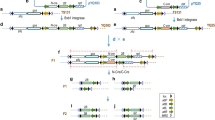Abstract
The Cre/lox site-specific recombination controls the excision of a target DNA segment by recombination between two lox sites flanking it, mediated by the Cre recombinase. We have studied the functional expression of the Cre/lox system to excise a transgene from the rice genome. We developed transgenic plants carrying the target gene, hygromycin phosphotransferase (hpt) flanked by two lox sites and transgenic plants harboring the Cre gene. Each lox plant was crossed with each Cre plant reciprocally. In the Cre/lox hybrid plants, the Cre recombinase mediates recombination between two lox sites, resulting in excision of the hpt gene. The recombination event could be detected because it places the CaMV 35S promoter of the hpt gene adjacent to a promoterless gusA gene; as a result the gusA gene is activated and its expression could be visualized. In 73 Cre/lox hybrid plants from various crosses of T0 transgenic plants, 19 expressed GUS, and in 132 Cre/lox hybrid plants from crosses of T2 transgenic plants, 77 showed GUS expression. Molecular data proved the excision event occurred in all the GUS+ plants. Recombination occurred with high efficiency at the early germinal stage, or randomly during somatic development stages.
Similar content being viewed by others
Author information
Authors and Affiliations
Additional information
Received. 2 April 2001 / Accepted: 29 June 2001
Rights and permissions
About this article
Cite this article
Hoa, T., Bong, B., Huq, E. et al. Cre/lox site-specific recombination controls the excision of a transgene from the rice genome. Theor Appl Genet 104, 518–525 (2002). https://doi.org/10.1007/s001220100748
Issue Date:
DOI: https://doi.org/10.1007/s001220100748




